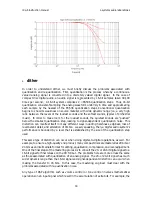
rdq-6 instruction manual
z-systems audio laboratories
12
F
IGURE
11
How to do it. With the rdq-6 in normal operating mode, the display will show all of the
parameters for the low shelf filter, filters 1, 2, 3, 4 and the hi shelf filter across the screen from
left to right. These parameters are organized in block form with the filter gain at the top,
center frequency in the middle and the slope value on the bottom line. Pressing one of the
six buttons directly underneath any of these parameter blocks will bring that filter into focus.
Figure 11 shows the rdq-6 as if the button for filter 3 had been hit (ignore for now the
particular values assumed by the various parameters). In this state, the three knobs control
the various parameters for bell filter 1; the knob below the gain display controls the amount
of boost/cut, the knob below the frequency display controls the center frequency, and the
knob below the slope display controls the slope. The audio signal is affected in real-time
when any of the parameters are changed. Pressing the button underneath
EXIT
will take you
back to the normal operating mode and the display for the filter you just changed will be
updated with the new parameters.
F
IGURE
12
Next, press the button underneath the low shelf filter parameters. The display changes as
shown in Figure 12. Notice there is no value of slope shown; this is because the low-shelf filter
has a fixed slope, which cannot be modified by the user. The corner frequency and gain
parameters for the low-shelf filter are adjusted in the same manner as with the bell filter. The
same is true for the high-shelf filter. All six filters in each channel can be set in this manner;



























